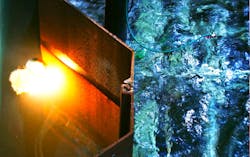Working underwater is personnel- and time-intensive, so the Laser Zentrum Hannover e.V. (LZH) and the Institute of Materials Science of the Leibniz Universität Hannover (both in Hannover, Germany) are developing an automated laser-based process for cutting sheet piling underwater.
Sheet piling protects fortified shore areas, or can be used to dry out these areas if repairs are necessary. If the sheet piling needs to be dismantled, divers must cut the walls into smaller pieces using a cutting torch.
Normally, a diver can cut about 20 meters a day, which corresponds to a speed of about 0.07 meters per minute. In the project LuWaPro, scientists at the LZH have now developed a process that uses a disk laser for torch cutting. The divers thus only carries out a supervisory role. The process can be used to separate the metal sheets, which are usually 10 mm thick for sheet piling, at speeds of up to 0.9 m/min.
Robust process despite unfavorable conditions
Poor visibility, currents, or uneven surfaces make working underwater more difficult. The scientists of the Underwater Technology Group achieved a position tolerance of about 2 mm in their process, enabling the system to react robustly to possible impacts during underwater operation. The process was tested with two scenarios: On the one hand, stand-alone metal sheets were cut underwater; on the other hand, the sheets were backfilled with concrete. In the second scenario, a leaking of the molten material through the cutting kerf is achieved by tilting the laser head at an angle of 20°.
A further major advantage in comparison to the hand-guided process is the possibility of monitoring the process. Sensors reliably determine whether a cut is completed or not. This is beneficial because otherwise the diver often cannot see this due to the poor visibility underwater.
Safe laser cutting underwater
The laser safety necessary for this process can be guaranteed if the diver wears conventional safety goggles under the helmet.
The project “Laser cutting under water for high productivity – LuWaPro” was supported by the German Federal Ministry for Economic Affairs and Energy.
Source: LZH

John Wallace | Senior Technical Editor (1998-2022)
John Wallace was with Laser Focus World for nearly 25 years, retiring in late June 2022. He obtained a bachelor's degree in mechanical engineering and physics at Rutgers University and a master's in optical engineering at the University of Rochester. Before becoming an editor, John worked as an engineer at RCA, Exxon, Eastman Kodak, and GCA Corporation.
